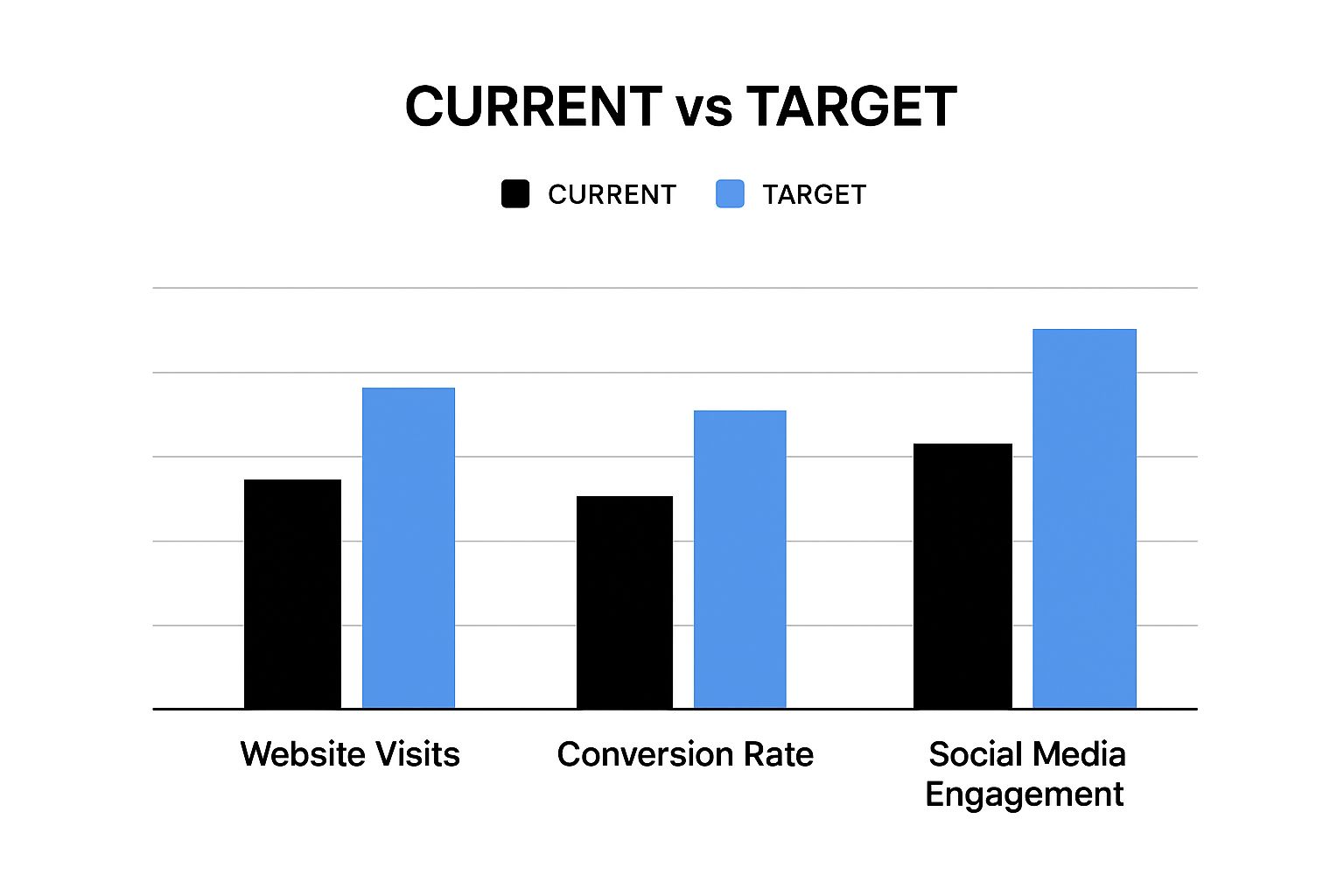Why Your Startup Marketing Plan Template Actually Matters
Let's be real—the phrase "marketing plan" can make you think of a thick, dusty binder that gets written once and then forgotten in a shared drive. For a startup moving at the speed of light in the buzzing UAE market, sitting down to write one can feel like a pointless chore when you could be out there doing things. The urge to just "wing it" is powerful.
But here’s the hard truth: winging it is one of the fastest ways to burn through your seed money with nothing to show for it. It's not just a gut feeling; research shows that startups with a documented marketing strategy are 2.5x more likely to secure funding. A solid plan isn't a set of rigid rules; it's your strategic compass in a very crowded marketplace.
From Static Document to Strategic Compass
The biggest mistake you can make is treating your startup marketing plan template like a stone tablet. A truly useful plan is a living, breathing document. Think of it as a navigation app versus a printed map. The app sees a traffic jam ahead and reroutes you. Your marketing plan needs to be that nimble, adapting to market feedback, what your competitors are up to, and your own performance data.
This approach transforms the plan from a box-ticking exercise into your most valuable decision-making tool. It forces you to define what success actually looks like—not in fuzzy terms, but with concrete Key Performance Indicators (KPIs). This clarity is what stops you from pouring your budget into activities that feel productive but deliver zero real results.
What Investors in the Region Want to See
When you’re pitching for capital, investors aren't just betting on your great idea; they're betting on your ability to execute. A thought-out marketing plan is your proof. It shows you’ve done the homework on your target audience, have a believable plan to win customers, and have seriously considered your path to making money. In the competitive MENA startup world, this level of preparation isn't optional.
The competition for funding here is intense. In 2023 alone, MENA startups pulled in $3.94 billion across 795 deals, showing just how much investor confidence is rising. A sloppy or nonexistent plan screams risk and a lack of foresight—a red flag that can end a conversation before it even starts. Discover more about the regional funding boom.
Building a Plan That Bends, Not Breaks
A strong marketing plan gives you guardrails, not a cage. The goal is to build a framework that allows you to pivot quickly based on real data. Your big-picture strategic goals—like hitting a certain revenue target or capturing a slice of the market—should stay fairly constant. But the tactics you use to get there should be treated like experiments.
Maybe you think LinkedIn ads will be your golden ticket, but after a month, the data shows you’re getting incredible engagement on Instagram for a fraction of the cost. A flexible plan lets you confidently shift your budget to double down on what's working, without feeling like you've derailed the whole strategy. And if one channel like Instagram starts showing huge promise, you might even drill down with a more focused Instagram Marketing Plan Template to really nail it.
An adaptable plan should always include:
- Clear, high-level goals that act as your North Star.
- Small, testable ideas for different channels and campaigns.
- A regular schedule (think weekly or bi-weekly) to look at the data and see what’s working.
- "What if" plans for when your key assumptions turn out to be wrong.
Understanding Your Market Beyond Basic Demographics
It’s easy to think of your target market as a list of stats on a spreadsheet. But in a place as diverse as the UAE, demographics like age and location barely tell you anything important. A truly effective startup marketing plan template is built on knowing the people you want to serve, not just their data. It’s about understanding the why behind their decisions, which is far more powerful than just knowing the who.

Creating Customer Personas That Resonate in the UAE
Let's move past the bland, generic personas you see in textbooks. Instead of a vague "Female, 25-35, living in Dubai," we need to build a real character. Imagine you're launching a delivery service for sustainable, locally-sourced groceries. Your persona isn't a statistic; she's "Aisha, 32, a working mother in a Mirdif villa community."
So, what does this specific detail really tell us?
- Her Aspirations: Aisha wants to provide healthy options for her family. She’s becoming more eco-conscious, influenced by global trends but seeking out authentic local products.
- Her Pain Points: She's short on time, and a trip to the supermarket with the kids in tow is a major headache. She’s also grown skeptical of the "fresh" promises made by big supermarket chains.
- Her Influences: A recommendation from another mom in her community WhatsApp group carries more weight than any flashy ad. She follows a couple of local food bloggers who value authenticity.
This is the kind of detail that shapes your entire strategy. It shows that your marketing shouldn't just be about "convenience." It should be about "community trust" and "wholesome choices for your family." You’re not just selling groceries; you're selling peace of mind to a specific person with real-world worries and hopes. This detailed picture helps you craft messages that connect, whether you're targeting a young Emirati professional or an expat family.
Low-Budget Research That Actually Works
Think you need a hefty research budget to get these kinds of insights? Think again. Some of the most valuable information is hiding in plain sight, and it’s often free. Your job is to become an expert listener and observer in the digital spaces where your ideal customers hang out.
Start by exploring the right communities:
- Community Forums & Groups: Become a fly on the wall in local Facebook groups (like "Brits in Dubai") or subreddits such as r/dubai. What problems are people trying to solve? What are their biggest complaints about the services they already use? The raw, unfiltered conversations here are pure gold.
- Competitor Social Media: Don't just glance at what your competitors are posting—read the comments. What do their followers love? What frustrates them? You’ll spot unmet needs and service gaps without spending a dirham.
- Simple Surveys: Use a free tool like Google Forms to create a quick, 5-question survey. Share it in these groups, not as a promotion, but by genuinely asking for help. You’d be surprised how many people are willing to share their opinions if you're authentic about it.
These grassroots methods are vital for building a solid digital presence. If you're wondering how this research fits into the bigger picture, you can explore our guide on digital marketing for startups, which shows you what comes next.
To give you a head start, here are some of my go-to tools for digging into market data without breaking the bank.
Essential Market Research Tools for UAE Startups
This table compares a few free and paid market research tools, highlighting their features, costs, and how effective they are for startups focusing on the region.
| Tool Name | Cost | Best For | Regional Data | Ease of Use |
|---|---|---|---|---|
| Google Trends | Free | Gauging keyword interest and seasonality over time. | Excellent (UAE) | Very Easy |
| AnswerThePublic | Freemium | Finding the exact questions people are searching for. | Good | Easy |
| Facebook Ad Library | Free | Analyzing your competitors' live ad campaigns and creative. | Excellent (UAE) | Easy |
| Statista | Freemium / Paid Plans | Accessing high-level market statistics and industry reports. | Good (MENA focus) | Medium |
As you can see, a mix of free and freemium tools can give you a solid foundation of data to work with.
This deep dive into your audience's world helps you move beyond competing on price and start connecting on shared values. It’s how you find a genuine gap in the market. For instance, instead of another generic fitness app, your research might uncover a need among new mothers in Abu Dhabi for postnatal-safe workouts they can do at home. Now that is a powerful niche.
Ultimately, this market analysis is the most important part of your startup marketing plan template. Every single decision you make—from which social media channels you use to the words you write in your ads—will flow from this deep understanding. When you get this right, you’re no longer just shouting into the void; you’re starting a real conversation with the people who are waiting to hear from you.
Building Your Digital Strategy in the UAE Market

You can't just take a marketing plan that works in the West and expect it to succeed in the UAE. This market is in a class of its own, with some of the highest internet and smartphone penetration rates on the planet. This isn't just about having a website and a few social profiles; it's about operating where digital is the default. Your startup marketing plan template has to be built for this mobile-first world from the ground up, focusing on platforms and content that actually fit into your customers' daily lives.
Choosing Your Battlegrounds: Which Platforms Deliver ROI?
As a startup, your budget is tight, so trying to be on every platform is a recipe for disaster. The trick is to pick your spots and go where your target audience truly lives online. While Facebook is still in the game, for many consumer-focused startups, the real engagement is on visual-heavy platforms like Instagram and TikTok. A modest fashion brand, for instance, would thrive here, using Reels and Stories to show off its designs in a way that feels native and exciting.
For B2B or fintech startups, the conversation happens elsewhere. LinkedIn is your main stage for building authority and connecting with key decision-makers. But don't sleep on WhatsApp. In the UAE, it's the standard for customer service and direct contact. A quick service update or a direct answer to a question on WhatsApp builds a kind of trust and speed that email just can't compete with. Your plan needs to be crystal clear about which channels are primary and which are secondary, so you can pour your limited resources where they'll make a real difference.
Content That Connects, Not Just Sells
Once you know where you’ll be talking, you need to figure out how to talk. This means speaking your audience's language, both literally and figuratively. English is common for business, but dropping in colloquial Arabic phrases or creating dedicated Arabic content shows you get it. It’s a sign of respect for the local culture that can set you miles apart from the competition.
The content itself has to be valuable, not just a sales pitch. Your goal is to build a community, not just a customer list. A health-tech startup could share short, helpful wellness tips from local experts. A food delivery app could repost user-generated content, celebrating customers' photos of their meals. This creates social proof and makes your brand feel like it's part of the local fabric. To get this right, you have to know your audience inside and out; digging into various audience research methods is how you find the insights to make your content feel genuine. Authenticity wins, every single time.
Smart Spending: Paid Advertising and Influencers
Hoping your posts go viral organically is not a strategy. You need a smart paid advertising budget to get real traction. The great thing is that ad platforms offer incredibly detailed targeting for the UAE, letting you reach precise groups, from high-income expats in Dubai Marina to Emirati families in Abu Dhabi. Treat your first campaigns like experiments. Run small A/B tests on your ad copy, visuals, and audiences to see what clicks before you go all in. This careful, data-first approach will save you from burning through cash on ads that don't work.
Influencer marketing is another major force in the region, but it demands careful research. Focus on authentic connection, not just a massive follower count. A micro-influencer with 10,000 highly engaged local followers who genuinely align with your brand is often far more effective than a macro-influencer with a million generic ones. This kind of thoughtful spending on digital tools is part of a larger movement. The digital marketing software market in the UAE is expected to reach almost $1.12 billion in 2024, leading the entire Middle East and Africa. This massive market growth shows a clear commitment from businesses to invest in the right tech to get customer attention and prove their return.
Choosing Marketing Tools That Actually Move the Needle
The world of marketing technology can feel like a candy store for startups—every shiny new tool promises to be the one thing you’re missing. It’s tempting to sign up for every free trial and demo, but that approach quickly burns through your budget and focus. Your startup marketing plan template should be the one dictating which tools you need, not the other way around. It's about finding a lean tech stack that helps you hit your goals without creating financial bloat or a massive learning curve.
Building Your Foundational Tech Stack
Before you get lost in the possibilities of advanced automation or AI, you have to get the basics right. These are the non-negotiable tools that form the backbone of any marketing operation. The great news is that many of them offer robust free versions to get you off the ground.
Your initial stack should cover these core needs:
- A Customer Relationship Manager (CRM): This is your command center for all customer data. A free tool like the HubSpot CRM tracks leads from their first visit to your site all the way to their final purchase. It ensures that no conversation or potential deal gets lost in the shuffle.
- Web Analytics: You can't fix what you can't see. Google Analytics is essential for understanding how people find and use your website. The key is to move beyond just looking at traffic numbers and set up specific conversion goals, like form submissions or newsletter sign-ups. This tells you which of your marketing efforts are actually driving results.
- Communication Platforms: Consistency is what separates proactive marketing from reactive chaos. A social media scheduler like Buffer or an email marketing platform like Mailchimp lets you plan and schedule your content in batches. This frees you up to think strategically instead of scrambling to post something every day.
These foundational tools are all about turning your marketing activities into clear, measurable data. For instance, your core tools should give you a straightforward view of your progress toward key performance indicators.

A visual like this instantly shows you where you're winning—like social engagement—and where you need to apply more effort, such as closing the gap on your website visit goals.
So, how should you actually budget for these tools as your startup grows? Your spending priorities will naturally shift over time. Here’s a recommended breakdown of how your tech budget might be allocated as you move from the early days to a full-scale operation.
Startup Marketing Technology Budget Allocation
Recommended budget distribution across essential marketing tools for different startup stages and sizes
| Tool Category | Early Stage % | Growth Stage % | Scale Stage % | Priority Level |
|---|---|---|---|---|
| CRM & Analytics | 35% | 25% | 20% | High |
| Content & Communication | 40% | 30% | 25% | High |
| SEO & Optimization | 15% | 20% | 20% | Medium |
| Automation & AI | 10% | 25% | 35% | Low -> High |
As you can see, the focus starts with core communication and tracking in the early stage, then gradually shifts toward automation and deeper optimization as you scale. This ensures you're spending money on tools that solve today's problems, not investing too early in solutions for tomorrow's.
Scaling with Smarter Tools and AI
Once you have the fundamentals locked down and revenue is flowing more consistently, you can begin to invest in tools that buy back your time and amplify your efforts. This isn't just a hunch; the investment in marketing technology is surging because smart businesses are getting a real competitive advantage. For example, the MarTech market in the Middle East is projected to hit nearly $8.29 billion in 2024 and is growing at an impressive 20.2% annually through 2033. Discover the insights behind this regional growth.
Upgrading your tech stack might look something like this:
- Marketing Automation: This is where you reclaim huge chunks of your day. Imagine a customer adds an item to their cart but doesn't check out. An automation tool can instantly send them a reminder email with a small discount, recovering a sale you would have otherwise lost without you lifting a finger.
- AI-Powered Assistants: AI is not about replacing your team; it’s about making them more powerful. An AI copywriting assistant can help you brainstorm five different ad headlines in minutes. AI-driven SEO tools can analyze top-ranking competitors and generate a detailed content brief, giving your articles a much better shot at ranking on Google.
The guiding principle should always be purpose. Don’t add a new tool because it’s popular; add it because it solves a specific problem you've identified in your marketing plan. The right tech stack empowers a small team to execute with the precision and impact of a much larger one.
Creating Content That Builds Authority and Drives Growth
Content is supposed to be the engine for your marketing, but it's incredibly easy to get it wrong. Too many startups fall into the trap of churning out generic blog posts, shouting into an empty room and wondering why no one's listening. Great content marketing isn't about how much you can produce; it’s about building trust and making your brand the undeniable expert. This part of your startup marketing plan template is where you map out how you'll create content that actually solves problems, not just gets clicks.
The mission is to shift from talking at your audience to having a conversation with them. This means your content needs to be so helpful that people start looking for it, sharing it, and eventually, trusting you enough to become customers. It's not an overnight trick, but it's the only way to build a loyal community that your competitors can't just poach.
From Keyword Lists to Customer Conversations
Your best content ideas won't come from a keyword tool. They'll come from the real-world questions and frustrations of the customer personas you've already defined. For example, instead of targeting a huge, generic keyword like "real estate," a prop-tech startup in Dubai should create content that answers a specific, local question: "What are the hidden costs of buying an apartment in Dubai Marina?" This instantly shows you get the unique problems of your market.
Think about the problems your product is built to solve, and then create educational content that addresses those issues before a customer even knows they need you.
- A fintech app could create a guide on "The Easiest Ways for Expats to Build a Credit History in the UAE."
- A healthy meal delivery service could publish "A 7-Day Meal Plan for Busy Professionals in DIFC."
- A B2B software company could write a case study on "How a Local Retailer Increased Footfall Using Our Tech."
This strategy goes beyond SEO; it’s about showing empathy. When you consistently answer real questions, you build a foundation of trust that is far more durable than a top spot on Google.
The Power of Repurposing: Work Smarter, Not Harder
As a startup, time is your most valuable asset. Creating brand-new content from scratch every single day is a recipe for burnout. The key is to adopt a "create once, distribute many times" philosophy. A single, high-value "pillar" piece of content can be your content goldmine, sliced and diced into dozens of smaller assets for different channels.
Let's say you write a definitive guide on setting up an e-commerce business in the UAE. That one big piece can become:
- Ten separate social media posts, each pulling out a key tip.
- A quick script for an Instagram Reel or TikTok video.
- A shareable infographic that visualizes the main steps.
- An exclusive checklist for your email subscribers.
- A script for a short, punchy podcast episode.
This approach lets you stay active and consistent across multiple platforms without exhausting your team. Don't forget about visual platforms, either. A well-designed infographic can be a huge hit on a channel like Pinterest, especially for e-commerce or lifestyle brands. To really make it work, a good Pinterest SEO Guide can show you how to get your visuals discovered by an entirely new audience.
Measuring What Moves the Business Forward
Likes and shares are nice, but they don't keep the lights on. Your content strategy has to connect directly to business goals. It's time to ignore the vanity metrics and focus on what really grows a business: leads, conversions, and customer acquisition. For every blog post, video, or guide you create, you need to ask: what action do we want someone to take? Is it signing up for a webinar, downloading an e-book (and giving you their email), or booking a product demo?
You have to track these conversions carefully. If a blog post gets thousands of views but generates zero leads, it's not working for you. On the other hand, a niche article that only a hundred people read but converts 10% of them into qualified leads is a massive success. This data-first mindset lets you focus your energy on the topics and formats that are actually building your business, turning your content strategy into a reliable growth machine.
Smart Budget Planning and Measuring What Matters

Alright, let's tackle the part of the plan that can make founders a bit anxious: the money. A brilliant strategy is just a nice document if you don't have a smart, realistic budget to bring it to life. This is where your startup marketing plan template becomes more than a to-do list; it’s your financial guide, showing you how to put every dirham to work for the biggest return. This isn’t about pinching pennies—it’s about spending with purpose.
From Guesswork to Goal-Based Budgeting
So, how much should you actually spend on marketing? You'll get all sorts of advice, like "dedicate 10% of your revenue," but that's pretty useless if you're pre-revenue or just getting off the ground. A much better way is objective-based budgeting. Instead of pulling a number out of thin air, you start with your goal and work backward.
Let’s say your objective is to acquire your first 100 paying customers in the next three months. Your main channel for this is targeted Instagram ads. You can start to estimate the cost by looking at a few key figures:
- Cost Per Click (CPC): AED 3.00
- Website Conversion Rate: 2% (meaning 2 out of every 100 visitors sign up for a trial)
- Lead-to-Customer Rate: 10% (meaning 1 out of every 10 trial users becomes a paying customer)
With these numbers, you can map out a projection to see what it takes to hit your goal. This approach connects your budget directly to business results, not some random percentage. For a more detailed look at this, our guide on setting a small business marketing budget can be a big help.
The Metrics That Tell the Real Story
In the early stages, it’s easy to get excited by what we call vanity metrics—things like social media likes or a spike in website traffic. While they feel good and can signal some brand awareness, they don't directly tell you if the business is healthy. To make smart budget choices and have a story that impresses investors, you need to track the numbers that matter.
The two most critical metrics for any startup are:
- Customer Acquisition Cost (CAC): This is the total amount you spend on sales and marketing to get one new customer. You calculate it by dividing your total marketing spend over a set period by the number of new customers you brought in during that same time.
- Lifetime Value (LTV): This is the total revenue you can realistically expect from a single customer over the entire time they do business with you.
The real insight comes when you compare these two. A sustainable business model usually has an LTV:CAC ratio of 3:1 or higher. If your ratio is 1:1, you're essentially losing money acquiring customers. If it's 5:1, you're doing exceptionally well and should probably be spending more to accelerate your growth.
Making Smart Pivots and Proving Your Worth
That LTV:CAC ratio is your decision-making engine. It clearly shows you where to invest more and where you might need to pull back. If you discover that your LinkedIn ads are bringing in customers with a fantastic LTV:CAC ratio but your Pinterest ads are burning through cash with little return, you have a clear, data-backed reason to shift your budget. Your marketing plan isn't meant to be set in stone; it's a living document—a hypothesis you are constantly testing and improving with real-world data.
Sometimes, a channel might have a high CAC but also brings in very valuable customers. Your job isn't always to cut it, but to figure out how to make it more efficient. For example, if Pinterest drives great customers but the ad costs are high, maybe you shift focus to organic growth on that platform to lower your overall acquisition cost. Boosting your content's organic visibility with strong SEO practices can make a huge difference. A thorough Pinterest SEO Guide could give you ideas on how to get more reach without spending more on ads. This is the kind of strategic thinking that turns a tight budget into a powerful growth asset.
Turning Your Plan Into Consistent Action
You've spent hours creating the perfect startup marketing plan template, and it's a work of art. But let's be real—a plan gathering digital dust in a folder doesn't generate leads. The real work begins when that strategy is put into motion through consistent, daily action. This is the exact point where many startups get stuck. It’s not about having the perfect plan; it's about building a system to execute it.
This means moving from a list of good ideas to a predictable engine for growth. It’s the shift from crossing your fingers and hoping for results to actually building a process that delivers them.
From Grand Vision to Weekly Wins
Those big, ambitious annual goals—like hitting a major revenue milestone or capturing a slice of the market—can feel completely out of reach. The secret is to stop staring at the mountain top and focus on the path right in front of you. You do this by breaking that huge goal down into quarterly objectives, then monthly targets, and finally into specific weekly tasks your team can actually tackle.
For example, let's say a quarterly goal is to generate 500 qualified leads. That number can feel paralyzing. But when you break it down, the weekly action plan becomes clear:
- Publish two blog posts optimized for specific long-tail keywords.
- Run a LinkedIn ad campaign promoting a new whitepaper.
- Send out one high-value newsletter to your current email subscribers.
Suddenly, the anxiety of a huge target is gone. It's replaced by a clear focus on what needs to be done this week to make progress. Everyone on the team knows their role, and you start building momentum through small, consistent wins.
The Rhythm of Review and Adaptation
Putting a plan into action without checking the results is like driving with your eyes closed. You need to build a regular rhythm of review to make sure you're heading in the right direction. This isn't about creating more meetings for the sake of it; it's about creating a dedicated feedback loop. Think weekly check-ins to see what’s happening on the ground and monthly deep-dives to look at the bigger picture and adjust your course.
A visual dashboard becomes your command center for these conversations. It pulls all your key metrics into one place so you can see what's happening at a glance.
A dashboard like this instantly highlights which channels are killing it and which ones are lagging. These review sessions are where you make the tough calls: do you pour more budget into that winning Facebook ad, or is it time to pull the plug on a blog topic that just isn't getting traction?
This is where having solid systems for effective marketing campaign tracking is non-negotiable. It provides the hard data you need to back up your decisions. This cycle of doing, reviewing, and adjusting keeps your marketing sharp and ensures you’re not just busy, but productive.
Putting all these pieces together and turning your strategy into a real, functioning machine can be tough, especially when you're juggling a dozen other startup priorities. If you need a partner to help execute your plan with focus and precision, Technogital offers marketing solutions designed for real-world results.

